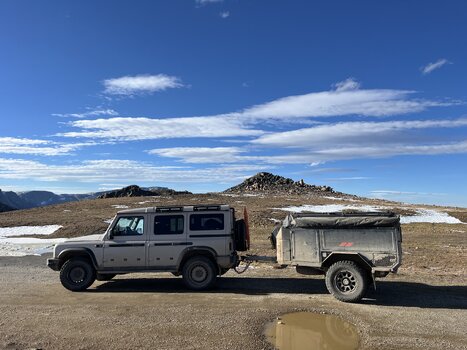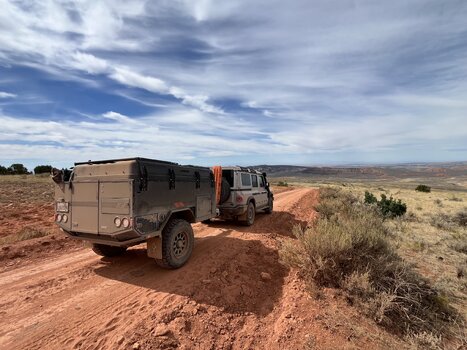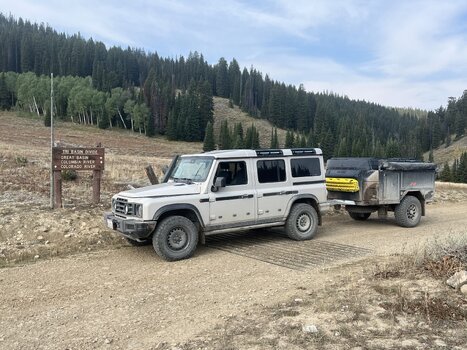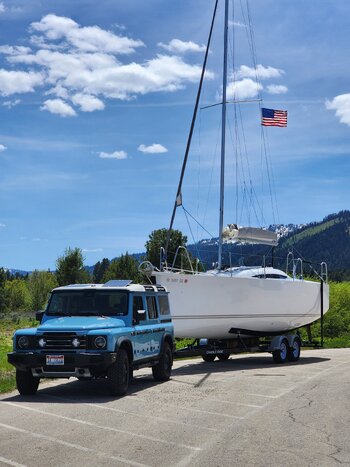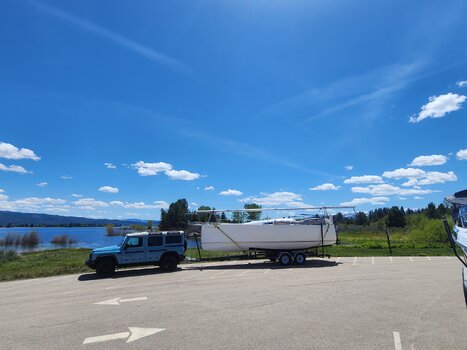That’s very re-assuring, I have done some long trips in mine and a fair bit of towing, but nowhere remote as yet. How deep was the deepest water you crossed?Kimberley Touring Western Australia
I have just returned from a trip to the Kimberley region of Western Australia in my diesel Grenadier Trialmaster, towing a 16ft hybrid pop-top off road caravan (tare weight 2000kg, loaded weight about 2400kg, tow ball weight approx 230kg).
Covered 8500km in 31 days: Perth to Kununurra (for the Ord River Muster) via Meekatharra, Newman, Port Hedland, 80 Mile Beach, Fitzroy Crossing and Halls Creek. A few days at Lake Argyle then back to El Questro Station (off the Gibb River Road) to Mt Hart Station via Halls Creek and Fitzroy Crossing (Gibb River Rd direct to Mt Hart from the north east was closed due to high water at the Pentecost River crossing), Derby, Dampier Peninsula/Cape Leveque (for 3 days), back to the Great Northern Highway (via Marble Bar) and home to Perth.
I was very nervous before I set out: no Ineos service centres in WA other than Perth and no spares north of Perth.
The Grenadier never missed a beat, fantastic to drive over long distances (even when towing), 6 – 8 hours at the wheel most days, comfortable Recaro seats. Brilliant performance on the roads, both corrugated dirt and bitumen, plenty of power for overtaking 60 meter road trains (even uphill) and reasonable fuel consumption (overall average for the 8500km was 15.3 L/100km and about 80% of the total distance was towing). The right hand drive, left foot hump is a total non-issue for me…… don’t even notice it.
14.5 to 16.0 L/100km towing with a tailwind and 16.0 to 17.8 into a headwind or in hilly terrain (according to the average fuel consumption on the info system). The vehicle with caravan sits happily in 8th gear at 1600rpm, handles gentle uphill slopes without a downshift and only drops into 7th (or occasionally 6th gear) on the steeper hills. I usually sat on 90 - 95km/hr into the wind and 95 – 100km/hr downwind. Fuel consumption rises rapidly above 100km/hr when towing, especially into the wind.
This is the best and most capable long distance touring vehicle I have ever driven. It handled beach sand, rough corrugated dirt roads, flooded creek crossings, rough rocky terrain and slippery muddy tracks with ease (while towing). I engaged low gear and the central locker (plus wading mode) fairly often, but never looked like needing the rear or front axle lockers.
My caravan is two wheel with independent trailing arm suspension,12 inch electric drum brakes and 265/75/R16 mud terrain tyres on alloy rims (I carry two spares). A Redarc Tow-Pro Elite electronic brake controller is fitted to the Trialmaster.
Cheers
Wombat51
The Grenadier Forum
Register a free account today to become a member! Once signed in, you'll be able to contribute to the community by adding your own topics, posts, and connect with other members through your own private inbox! INEOS Agents, Dealers or Commercial vendors please contact admin@theineosforum.com for a commercial account.
Towing With The Grenadier
- Thread starter bikesandguitars
- Start date
Sorry about delayed response, just noticed your question.
Depth of deepest water crossing was approx 550-600 mm.........water just seeped into door step depression on caravan . But no issues for the Grenadier.
Wombat51
Depth of deepest water crossing was approx 550-600 mm.........water just seeped into door step depression on caravan . But no issues for the Grenadier.
Wombat51
thanks Wombat. My Grenadier is going into the auto elec this week to get the Redarc Tow-Pro. where did you decide to put the control button? I haven't figured what to do about that.Kimberley Touring Western Australia
I have just returned from a trip to the Kimberley region of Western Australia in my diesel Grenadier Trialmaster, towing a 16ft hybrid pop-top off road caravan (tare weight 2000kg, loaded weight about 2400kg, tow ball weight approx 230kg).
Covered 8500km in 31 days: Perth to Kununurra (for the Ord River Muster) via Meekatharra, Newman, Port Hedland, 80 Mile Beach, Fitzroy Crossing and Halls Creek. A few days at Lake Argyle then back to El Questro Station (off the Gibb River Road) to Mt Hart Station via Halls Creek and Fitzroy Crossing (Gibb River Rd direct to Mt Hart from the north east was closed due to high water at the Pentecost River crossing), Derby, Dampier Peninsula/Cape Leveque (for 3 days), back to the Great Northern Highway (via Marble Bar) and home to Perth.
I was very nervous before I set out: no Ineos service centres in WA other than Perth and no spares north of Perth.
The Grenadier never missed a beat, fantastic to drive over long distances (even when towing), 6 – 8 hours at the wheel most days, comfortable Recaro seats. Brilliant performance on the roads, both corrugated dirt and bitumen, plenty of power for overtaking 60 meter road trains (even uphill) and reasonable fuel consumption (overall average for the 8500km was 15.3 L/100km and about 80% of the total distance was towing). The right hand drive, left foot hump is a total non-issue for me…… don’t even notice it.
14.5 to 16.0 L/100km towing with a tailwind and 16.0 to 17.8 into a headwind or in hilly terrain (according to the average fuel consumption on the info system). The vehicle with caravan sits happily in 8th gear at 1600rpm, handles gentle uphill slopes without a downshift and only drops into 7th (or occasionally 6th gear) on the steeper hills. I usually sat on 90 - 95km/hr into the wind and 95 – 100km/hr downwind. Fuel consumption rises rapidly above 100km/hr when towing, especially into the wind.
This is the best and most capable long distance touring vehicle I have ever driven. It handled beach sand, rough corrugated dirt roads, flooded creek crossings, rough rocky terrain and slippery muddy tracks with ease (while towing). I engaged low gear and the central locker (plus wading mode) fairly often, but never looked like needing the rear or front axle lockers.
My caravan is two wheel with independent trailing arm suspension,12 inch electric drum brakes and 265/75/R16 mud terrain tyres on alloy rims (I carry two spares). A Redarc Tow-Pro Elite electronic brake controller is fitted to the Trialmaster.
Cheers
Wombat51
See attached photo. The control button is located RHS of steering wheel as you can see, easy access if you are right handed. The actual Redarc brake control unit is located on the top inside edge of the trim panel below (blue marking). Brake signal from RHS rear trailer wiring is routed along the floor sill and up through the kick panel to the right and below the control button (next to the accelerator pedal). Positive power (when ignition turned on) comes from one of the spare fuse positions in the central fuse box under rear seat (also routed across the rear electrical compartment under the rear seat and along the RHS floor sill). There is a negative/earth bolt/nut somewhere behind the pedals I used for ground.

Another option is to put the Redarc controller in the same place, but mount it on a Lightforce switch panel, giving you extra options (if needed). More information here, with part numbers.thanks Wombat. My Grenadier is going into the auto elec this week to get the Redarc Tow-Pro. where did you decide to put the control button? I haven't figured what to do about that.

Do you have any problems with trailer lamp warning alarms when no trailer is connected? I do occasionally, but particularly immediately after a trailer is disconnected.See attached photo. The control button is located RHS of steering wheel as you can see, easy access if you are right handed. The actual Redarc brake control unit is located on the top inside edge of the trim panel below (blue marking). Brake signal from RHS rear trailer wiring is routed along the floor sill and up through the kick panel to the right and below the control button (next to the accelerator pedal). Positive power (when ignition turned on) comes from one of the spare fuse positions in the central fuse box under rear seat (also routed across the rear electrical compartment under the rear seat and along the RHS floor sill). There is a negative/earth bolt/nut somewhere behind the pedals I used for ground.
View attachment 7862640
I want to install a Redarc brake controller on my Gren, installed one on my Defender and my wife's Range Rover and they work great. Which model of Redarc are you all using and which wiring harness did you use? Redarc website doesn't list the Ineos Grenadier yet. Thanks.
Nice! What did you do for brake controller and overall 7 Pin wiring harness?Just a note to always keep a hitch extender handy when towing. I originally hooked up this trailer without an extender but the spare tire was only an inch or so from the tongue jack controller. I had to add the hitch extension and a few links of chain. I towed the camper - Airstream Basecamp @ 1700 lbs - for approx 100 miles. I hardly knew it was there.
View attachment 7849503
Hi all, was hoping to gleam some "real world' based knowledge on towing a relatively heavy travel trailer on US roads, including highways, small backroads, and some tame but at times corrugated forest service roads. The trailer in question is a 2024 inTech Aucta Magnolia, (https://intech.com/rv/models/aucta/magnolia/) 22'6" long, 8'4" wide, weight range = 4,764 - 5,200 lbs., tongue weight = 475-500 lbs. GVWR = 7,500 lbs. I've got about 13,000 miles on my Trialmaster with stock tires/ride height, and have found towing my Patriot X3 Gen2 trailer (pictured below) to be stress free in all conditions at all legal speeds, and including some fairly technical BDR type terrain. The inTech trailer will be for longer more glamping style trips in the Western US, and Canada (i.e. lots of mountain passes).
My questions for anyone with experience towing with the Grenadier are:
- What is the heaviest/longest trailer you've comfortably towed?
- How did you get around the somewhat recessed tow receiver location relative to the spare tire, and with US trailer manufacturers using short trailer tongues with power tongue jacks (e.g. Airstream)?
- Have you found a weight distribution hitch to be a requirement, and if so, what did you go with? I've looked at the ProPride 3P trailer sway control hitch, but this looks like overkill and possibly difficult to align/connect, especially given the IG back up camera being poorly located to aid in backing up to a trailer. I find myself getting in and out of the vehicle several times to hook up the very simple DO35 on the Patriot.
- Do you have any recommendations for a simple but effective weight distribution/sway control set up to limit or minimize sway? I want to be able to drop the trailer off fairly quickly at a "basecamp" and conversely quickly hook it back up, minimizing set up tear/down time.
- With the rather large turning radius of the IG, is getting in/out of US campsites unreasonably challenging?
Generally, is towing this sized trailer a reasonable ask of the Grenadier, and is there anything else that I should be aware of?
Based on the limited posts here and elsewhere, I think it is within the Grenadiers capabilities, but I'd still feel better knowing what others have found. Those in Australia are comfortably towing large caravans in the outback, and in the UK heavy loads of livestock, but I feel US roads pose some different challenges.
I'd appreciate any and all thoughts!
My questions for anyone with experience towing with the Grenadier are:
- What is the heaviest/longest trailer you've comfortably towed?
- How did you get around the somewhat recessed tow receiver location relative to the spare tire, and with US trailer manufacturers using short trailer tongues with power tongue jacks (e.g. Airstream)?
- Have you found a weight distribution hitch to be a requirement, and if so, what did you go with? I've looked at the ProPride 3P trailer sway control hitch, but this looks like overkill and possibly difficult to align/connect, especially given the IG back up camera being poorly located to aid in backing up to a trailer. I find myself getting in and out of the vehicle several times to hook up the very simple DO35 on the Patriot.
- Do you have any recommendations for a simple but effective weight distribution/sway control set up to limit or minimize sway? I want to be able to drop the trailer off fairly quickly at a "basecamp" and conversely quickly hook it back up, minimizing set up tear/down time.
- With the rather large turning radius of the IG, is getting in/out of US campsites unreasonably challenging?
Generally, is towing this sized trailer a reasonable ask of the Grenadier, and is there anything else that I should be aware of?
Based on the limited posts here and elsewhere, I think it is within the Grenadiers capabilities, but I'd still feel better knowing what others have found. Those in Australia are comfortably towing large caravans in the outback, and in the UK heavy loads of livestock, but I feel US roads pose some different challenges.
I'd appreciate any and all thoughts!
Attachments
Hi all, was hoping to gleam some "real world' based knowledge on towing a relatively heavy travel trailer on US roads, including highways, small backroads, and some tame but at times corrugated forest service roads. The trailer in question is a 2024 inTech Aucta Magnolia, (https://intech.com/rv/models/aucta/magnolia/) 22'6" long, 8'4" wide, weight range = 4,764 - 5,200 lbs., tongue weight = 475-500 lbs. GVWR = 7,500 lbs. I've got about 13,000 miles on my Trialmaster with stock tires/ride height, and have found towing my Patriot X3 Gen2 trailer (pictured below) to be stress free in all conditions at all legal speeds, and including some fairly technical BDR type terrain. The inTech trailer will be for longer more glamping style trips in the Western US, and Canada (i.e. lots of mountain passes).
My questions for anyone with experience towing with the Grenadier are:
- What is the heaviest/longest trailer you've comfortably towed?
- How did you get around the somewhat recessed tow receiver location relative to the spare tire, and with US trailer manufacturers using short trailer tongues with power tongue jacks (e.g. Airstream)?
- Have you found a weight distribution hitch to be a requirement, and if so, what did you go with? I've looked at the ProPride 3P trailer sway control hitch, but this looks like overkill and possibly difficult to align/connect, especially given the IG back up camera being poorly located to aid in backing up to a trailer. I find myself getting in and out of the vehicle several times to hook up the very simple DO35 on the Patriot.
- Do you have any recommendations for a simple but effective weight distribution/sway control set up to limit or minimize sway? I want to be able to drop the trailer off fairly quickly at a "basecamp" and conversely quickly hook it back up, minimizing set up tear/down time.
- With the rather large turning radius of the IG, is getting in/out of US campsites unreasonably challenging?
Generally, is towing this sized trailer a reasonable ask of the Grenadier, and is there anything else that I should be aware of?
Based on the limited posts here and elsewhere, I think it is within the Grenadiers capabilities, but I'd still feel better knowing what others have found. Those in Australia are comfortably towing large caravans in the outback, and in the UK heavy loads of livestock, but I feel US roads pose some different challenges.
I'd appreciate any and all thoughts!
Fantastic tow vehicle unless going big american - e.g. Ram2500. Previous was LC100 and it is as good, likely better at towing.
3100kg
Relocated reversing camera to centre of rear door. 2" longer tongue (shaft) to accommodate bracket for 'stonestomper' stone guard.
No need for WDH. Too risky to use on anything other than blacktop. I have a 3800kg GVM upgrade with 35mm lift.
As above. Distribute trailer weight properly to eliminate sway. In Aus generally 8-10% on nose.
My van is 22ft + drawbar. Turning circle of the Ineos is not the issue.. it's having a 22+ft trailer hanging off the back.
At 3100kg trailer, the Ineos does this easily (mine is diesel however). It replaced an LC100 v8 petrol and I also have a Touareg diesel to compare - better than both IMHO.
The Grenadier is as good a tow vehicle as anything you'll find except a well-equipped pickup. I had a 2017 F150 short bed crew cab with the 3.5L Ecoboost. It is rated for 10,600 pounds, which is the highest capacity F150 before you have to go up to a 250. Towing my 26' sailboat (probably 30' overall trailer length) that is about 6500 pounds including trailer, I saw very little dropoff between the 150 and the Grenadier, including at 80 mph, over a 5 mile 8% grade up and another 5 miles back from down, and 50 miles of mountain curves at 65 mph. My rig uses surge brakes. I would tow to the Grenadier listed max weight with the stock hitch and electrical and just surge brakes without hesitation. My Grenadier has the KO2s on steel rims.Hi all, was hoping to gleam some "real world' based knowledge on towing a relatively heavy travel trailer on US roads, including highways, small backroads, and some tame but at times corrugated forest service roads. The trailer in question is a 2024 inTech Aucta Magnolia, (https://intech.com/rv/models/aucta/magnolia/) 22'6" long, 8'4" wide, weight range = 4,764 - 5,200 lbs., tongue weight = 475-500 lbs. GVWR = 7,500 lbs. I've got about 13,000 miles on my Trialmaster with stock tires/ride height, and have found towing my Patriot X3 Gen2 trailer (pictured below) to be stress free in all conditions at all legal speeds, and including some fairly technical BDR type terrain. The inTech trailer will be for longer more glamping style trips in the Western US, and Canada (i.e. lots of mountain passes).
My questions for anyone with experience towing with the Grenadier are:
- What is the heaviest/longest trailer you've comfortably towed?
- How did you get around the somewhat recessed tow receiver location relative to the spare tire, and with US trailer manufacturers using short trailer tongues with power tongue jacks (e.g. Airstream)?
- Have you found a weight distribution hitch to be a requirement, and if so, what did you go with? I've looked at the ProPride 3P trailer sway control hitch, but this looks like overkill and possibly difficult to align/connect, especially given the IG back up camera being poorly located to aid in backing up to a trailer. I find myself getting in and out of the vehicle several times to hook up the very simple DO35 on the Patriot.
- Do you have any recommendations for a simple but effective weight distribution/sway control set up to limit or minimize sway? I want to be able to drop the trailer off fairly quickly at a "basecamp" and conversely quickly hook it back up, minimizing set up tear/down time.
- With the rather large turning radius of the IG, is getting in/out of US campsites unreasonably challenging?
Generally, is towing this sized trailer a reasonable ask of the Grenadier, and is there anything else that I should be aware of?
Based on the limited posts here and elsewhere, I think it is within the Grenadiers capabilities, but I'd still feel better knowing what others have found. Those in Australia are comfortably towing large caravans in the outback, and in the UK heavy loads of livestock, but I feel US roads pose some different challenges.
I'd appreciate any and all thoughts!
I did not need a tongue extension because my trailer clears on the terrain I'd be taking it on.
As for lining up the trailer, this is the first vehicle I've had with a backup camera, so it's all gravy for me. I find if I raise the tongue only just far enough to clear the hitch then I can still line it up visually in one go without much trouble.
Hi all, was hoping to gleam some "real world' based knowledge on towing a relatively heavy travel trailer on US roads, including highways, small backroads, and some tame but at times corrugated forest service roads. The trailer in question is a 2024 inTech Aucta Magnolia, (https://intech.com/rv/models/aucta/magnolia/) 22'6" long, 8'4" wide, weight range = 4,764 - 5,200 lbs., tongue weight = 475-500 lbs. GVWR = 7,500 lbs. I've got about 13,000 miles on my Trialmaster with stock tires/ride height, and have found towing my Patriot X3 Gen2 trailer (pictured below) to be stress free in all conditions at all legal speeds, and including some fairly technical BDR type terrain. The inTech trailer will be for longer more glamping style trips in the Western US, and Canada (i.e. lots of mountain passes).
My questions for anyone with experience towing with the Grenadier are:
- What is the heaviest/longest trailer you've comfortably towed?
- How did you get around the somewhat recessed tow receiver location relative to the spare tire, and with US trailer manufacturers using short trailer tongues with power tongue jacks (e.g. Airstream)?
- Have you found a weight distribution hitch to be a requirement, and if so, what did you go with? I've looked at the ProPride 3P trailer sway control hitch, but this looks like overkill and possibly difficult to align/connect, especially given the IG back up camera being poorly located to aid in backing up to a trailer. I find myself getting in and out of the vehicle several times to hook up the very simple DO35 on the Patriot.
- Do you have any recommendations for a simple but effective weight distribution/sway control set up to limit or minimize sway? I want to be able to drop the trailer off fairly quickly at a "basecamp" and conversely quickly hook it back up, minimizing set up tear/down time.
- With the rather large turning radius of the IG, is getting in/out of US campsites unreasonably challenging?
Generally, is towing this sized trailer a reasonable ask of the Grenadier, and is there anything else that I should be aware of?
Based on the limited posts here and elsewhere, I think it is within the Grenadiers capabilities, but I'd still feel better knowing what others have found. Those in Australia are comfortably towing large caravans in the outback, and in the UK heavy loads of livestock, but I feel US roads pose some different challenges.
I'd appreciate any and all thoughts!
Forgot to include photos.
Attachments
Great input, and encouraging since 3100kg is probably more than I’ll tow, and the size and profile of your caravan is similar. Interesting comment on not needing a WDH. I believe the concern off road is placing stress on the caravan frame and in the case of the trailer I’m going with is key, as it is an aluminum structure on an aluminum frame. Or is it something else? Although, the use case for me is minimal or tame off road trips. So now that I know the IG can handle the weight, I’m wondering if I can safely tow on US roadways without a WDH. Thoughts anyone?Fantastic tow vehicle unless going big american - e.g. Ram2500. Previous was LC100 and it is as good, likely better at towing.
3100kg
Relocated reversing camera to centre of rear door. 2" longer tongue (shaft) to accommodate bracket for 'stonestomper' stone guard.
No need for WDH. Too risky to use on anything other than blacktop. I have a 3800kg GVM upgrade with 35mm lift.
As above. Distribute trailer weight properly to eliminate sway. In Aus generally 8-10% on nose.
My van is 22ft + drawbar. Turning circle of the Ineos is not the issue.. it's having a 22+ft trailer hanging off the back.
At 3100kg trailer, the Ineos does this easily (mine is diesel however). It replaced an LC100 v8 petrol and I also have a Touareg diesel to compare - better than both IMHO.
View attachment 7872463
More confidence inspiring input, thank you! That’s quite a load (and a beautiful boat) and the kind of roads I’ll be driving. I just towed the Patriot about 3,500 miles all over Idaho, Montana, and Wyoming. Just so I’m clear, you have no sway control, just brakes right? I already have a Redarc brake controller on the IG, so maybe I’m set.The Grenadier is as good a tow vehicle as anything you'll find except a well-equipped pickup. I had a 2017 F150 short bed crew cab with the 3.5L Ecoboost. It is rated for 10,600 pounds, which is the highest capacity F150 before you have to go up to a 250. Towing my 26' sailboat (probably 30' overall trailer length) that is about 6500 pounds including trailer, I saw very little dropoff between the 150 and the Grenadier, including at 80 mph, over a 5 mile 8% grade up and another 5 miles back from down, and 50 miles of mountain curves at 65 mph. My rig uses surge brakes. I would tow to the Grenadier listed max weight with the stock hitch and electrical and just surge brakes without hesitation. My Grenadier has the KO2s on steel rims.
I did not need a tongue extension because my trailer clears on the terrain I'd be taking it on.
As for lining up the trailer, this is the first vehicle I've had with a backup camera, so it's all gravy for me. I find if I raise the tongue only just far enough to clear the hitch then I can still line it up visually in one go without much trouble.
This blokes an engineer who can be interesting to watch. Heaps of other info out there. I have about 250kg on the ball, no airbags but have the 35mm lift due to gvm upgrade, rear of Grenny drops about 30 to 40mm and that's fine for me.Great input, and encouraging since 3100kg is probably more than I’ll tow, and the size and profile of your caravan is similar. Interesting comment on not needing a WDH. I believe the concern off road is placing stress on the caravan frame and in the case of the trailer I’m going with is key, as it is an aluminum structure on an aluminum frame. Or is it something else? Although, the use case for me is minimal or tame off road trips. So now that I know the IG can handle the weight, I’m wondering if I can safely tow on US roadways without a WDH. Thoughts anyone?
Interesting enough, I was touring about 6 months ago with a mate who does not take his van offroad. He has a WDH and cracked the A frame of his van in near exactly the same manner as in the second video below.
Yes, I'm driving with the stock hitch, no sway control or weight distributing hackery. Just a 2" ball and the trailer has surge brakes. Make sure your hitch is at the right height and you load your trailer for appropriate tongue weight and you should be great. Now, I also haven't done anything silly like lifted or leveled my truck. The engineers who designed it knew what they were doing and I'd rather have it tow effectively and have full suspension travel rather than sit there without rake when it's unloaded.More confidence inspiring input, thank you! That’s quite a load (and a beautiful boat) and the kind of roads I’ll be driving. I just towed the Patriot about 3,500 miles all over Idaho, Montana, and Wyoming. Just so I’m clear, you have no sway control, just brakes right? I already have a Redarc brake controller on the IG, so maybe I’m set.
Since it sounds like you may know the area, I drive my boat from Boise to Lake Lowell, CJ Strike, and up into the mountains to Donnelly via Highway 55. I had no trouble up or down keeping up with traffic or taking turns above the suggested speeds.
I towed a lighter boat of basically the same size with my FJ Cruiser and it would get squirrelly above 70-75 mph and definitely pushed me around a lot more. The Grenadier almost feels like it wants the weight and gets more solid under load. Only had one turn that I came into too hot and hit the brakes that I felt anything other than solid tracking.
My understanding is that there's a regulatory break at 7700 pounds that makes it a logical place to put the limit. I imagine this truck can tow more than the rating, though of course I wouldn't push it for liability reasons.
More great input, thanks again. When towing, I drive pretty conservatively (around 65-70 mph), even when the speed limits are up to 80mph. Doesn’t make me popular on the faster highways, but I’d rather have a decent margin of error should things go sideways or get squirrelly.Yes, I'm driving with the stock hitch, no sway control or weight distributing hackery. Just a 2" ball and the trailer has surge brakes. Make sure your hitch is at the right height and you load your trailer for appropriate tongue weight and you should be great. Now, I also haven't done anything silly like lifted or leveled my truck. The engineers who designed it knew what they were doing and I'd rather have it tow effectively and have full suspension travel rather than sit there without rake when it's unloaded.
Since it sounds like you may know the area, I drive my boat from Boise to Lake Lowell, CJ Strike, and up into the mountains to Donnelly via Highway 55. I had no trouble up or down keeping up with traffic or taking turns above the suggested speeds.
I towed a lighter boat of basically the same size with my FJ Cruiser and it would get squirrelly above 70-75 mph and definitely pushed me around a lot more. The Grenadier almost feels like it wants the weight and gets more solid under load. Only had one turn that I came into too hot and hit the brakes that I felt anything other than solid tracking.
My understanding is that there's a regulatory break at 7700 pounds that makes it a logical place to put the limit. I imagine this truck can tow more than the rating, though of course I wouldn't push it for liability reasons.
So considering your and @bakepl’s comments and the above videos of the potential downsides of WDH’s, I think I’ll proceed with the stock setup (steel wheels, BFG’s, no lift) pass on any weight distribution hackery as you called it, and just make sure the trailer is balanced, the hitch is at the right height, and the tongue weight is correct. It’s also reassuring how well it tows the Patriot at about 3000lbs fully loaded. Significantly lighter than the Intech I’m getting, but I forget it’s even back there.
Oh, and yes, familiar with the area, my son lives in Spokane, and we adventure quite a bit in ID, including sections of the IDBDR. Great state!
Thanks!
What size is the extender? Any issues going that route?Just a note to always keep a hitch extender handy when towing. I originally hooked up this trailer without an extender but the spare tire was only an inch or so from the tongue jack controller. I had to add the hitch extension and a few links of chain. I towed the camper - Airstream Basecamp @ 1700 lbs - for approx 100 miles. I hardly knew it was there.
View attachment 7849503
Yesterday was my first time towing with the Grenny. I pulled one of our boats down from Lake Arrowhed. Boat and trailer is about 5,500 pounds. Trailer brakes don’t work at all. Power was find but the brakes really didn’t like coming down the mountain. They got hot and experienced tremendous fade to the point were it was a bit scary. My wife’s Range Rover Sport had better brakes and doesn’t have this issue. My post full sized Range Rover was similarly under braked but improved with better aftermarket brake pads. Obviously, functioning trailer brakes would have made a big difference but this trailer only goes down the mountain once a year so I’m not motivated to fix it.
The other is issue was the damn stability control. It was part of what lead to overheating the brakes. The computer kept clamping brakes mid corner and completely unsettling everything. Nothing like the computer trying straight the truck and trailer out mid turn at 50 mph when you have a guard rail on one side and at rock wall on the other. I have been towing boats down this mountain for 45 years and don’t need “help” from a fucking computer. Is there any way to disable stability control?
The electronic nannies in this are going to cause an accident. Bongs when speed limit changes, bongs when changing lanes without a blinker, bongs when it goes under 1/2 a tank in fuel. All of this leads to me fumbling through menus trying to disable crap while driving. Someone needs to hack the system and let us turn this crap off.

The other is issue was the damn stability control. It was part of what lead to overheating the brakes. The computer kept clamping brakes mid corner and completely unsettling everything. Nothing like the computer trying straight the truck and trailer out mid turn at 50 mph when you have a guard rail on one side and at rock wall on the other. I have been towing boats down this mountain for 45 years and don’t need “help” from a fucking computer. Is there any way to disable stability control?
The electronic nannies in this are going to cause an accident. Bongs when speed limit changes, bongs when changing lanes without a blinker, bongs when it goes under 1/2 a tank in fuel. All of this leads to me fumbling through menus trying to disable crap while driving. Someone needs to hack the system and let us turn this crap off.
Trailer brakes are required in most states above 3000 pounds. In the People's Republic it's 1500, so I guess you got lucky to not get an inspection.Yesterday was my first time towing with the Grenny. I pulled one of our boats down from Lake Arrowhed. Boat and trailer is about 5,500 pounds. Trailer brakes don’t work at all. Power was find but the brakes really didn’t like coming down the mountain. They got hot and experienced tremendous fade to the point were it was a bit scary. My wife’s Range Rover Sport had better brakes and doesn’t have this issue. My post full sized Range Rover was similarly under braked but improved with better aftermarket brake pads. Obviously, functioning trailer brakes would have made a big difference but this trailer only goes down the mountain once a year so I’m not motivated to fix it.
The other is issue was the damn stability control. It was part of what lead to overheating the brakes. The computer kept clamping brakes mid corner and completely unsettling everything. Nothing like the computer trying straight the truck and trailer out mid turn at 50 mph when you have a guard rail on one side and at rock wall on the other. I have been towing boats down this mountain for 45 years and don’t need “help” from a fucking computer. Is there any way to disable stability control?
The electronic nannies in this are going to cause an accident. Bongs when speed limit changes, bongs when changing lanes without a blinker, bongs when it goes under 1/2 a tank in fuel. All of this leads to me fumbling through menus trying to disable crap while driving. Someone needs to hack the system and let us turn this crap off.
View attachment 7875082
I've towed 6500 pounds through the Idaho mountains at high speed with several very long descents using surge brakes and never had any fade or brake issues. I've also never had my stability control fire.
I wonder if there are other differences between our setup or if you just need to get your trailer brakes fixed before you kill someone.
Similar threads
- Replies
- 0
- Views
- 390
- Replies
- 231
- Views
- 18K

